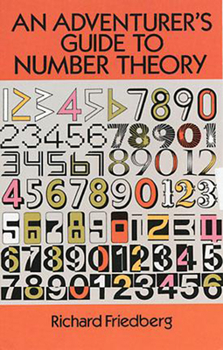An Adventurer's Guide to Number Theory
Select Format
Select Condition 
Book Overview
In this delightful guide, a noted mathematician and teacher offers a witty, historically oriented introduction to number theory, dealing with properties of numbers and with numbers as abstract... This description may be from another edition of this product.
Format:Paperback
Language:English
ISBN:0486281337
ISBN13:9780486281339
Release Date:January 1995
Publisher:Dover Publications
Length:240 Pages
Weight:0.60 lbs.
Dimensions:0.5" x 5.4" x 8.4"
Customer Reviews
5 ratings
What a carefully written exploration!
Published by Thriftbooks.com User , 22 years ago
I think this book is a masterpiece in mathematical exposition. All you need to know is how to add, subtract, multiply, and divide and maybe a vague memory of algebra. Mr. Friedberg will walk you through a lot of number theory after which (or maybe even during which) you may find a number theory textbook more approachable. If you read carefully you will really internalize what a proof by contradiction is and what an infinite descent is. You'll get a real appreciation for the logic of a proof and you'll see some ingenius tricks used by some great mathematicians ... and you'll understand them!This book is approachable and doable by anyone with a motivation for what can be understood about numbers. And I can't stress how carefully, thoughtfully, and articulately it is written.
"Quirky" is exactly the right word.
Published by Thriftbooks.com User , 23 years ago
A lot of us know that you can't double the square. You can't find two square whole numbers, one of which is twice the other. This, of course, is an ancient Greek problem.If b squared were equal to two times a squared, the right side of the equation would contain an odd factor of two, which is obviously impossible by the fundamental theorem of arithmetic. This is the modern way of proving this assertion.Richard Friedberg prefers the old way. He uses Fermat's method. On page 45 we read: "At each point we can prove that the numbers we have reached are even. So we can go on dividing forever. But this is impossible. Eventually we must reach 1, or some other odd number. Since we have proved something that is impossible, we must have assumed something that isn't true. The only thing we assumed was that there are two numbers a and b, such that two times a squared equals b squared. So there can be no such numbers."He continues in this way all the way to quadratic recipocity, and concludes with a Table of Theorems, all rigorously proved in his own quirky way.I continue to be frustrated by Friedberg's approach to number theory. It is historically accurate but very difficult to assimilate or combine into present day orthodoxy. I'm not sure whether he is worth my time, but nevertheless I continue to study his book. I've read it on and off now for more than five years. There is no doubt in my mind that he is a genius . . . hence the five stars. Whether one wants to embark on this slippery slope of classical geometry, historical number theory, the defects in Euler's reasoning and other incredibly obscure topics in number theory, the reader must decide for himself or herself. I don't think I'll ever know as much about the history of number theory as Richard Friedberg does, so I decided to put in my two cents mid-way through the course of my studies.
great book
Published by Thriftbooks.com User , 24 years ago
great light reading for anyone who is interested in number theory. basic understanding of mathematics required
Really four-and-a-half stars...
Published by Thriftbooks.com User , 24 years ago
...but the dropdown allows you to pick either four or five; I felt generous. This book is great in that I managed to become "number-theory literate" in a matter of days. Historical tidbits not only make the book flow smoothly, but make it fun to read. The actual mathematical content that is covered nails down the fundamental concepts of number theory pretty well. For clarity, the author is generous with examples. My only complaint is that the writing, while clear and conversational, is almost too conversational. In the first part of the book, you have to question the author's mathematical background when he makes an embarassing claim and corrects himself in a footnote. Granted, we're all human, but this is a book for goodness sake, you can take your words back! Also, the examples occasionally skip steps, forcing you to stare at the problem longer if it's not clear to you what happened. This isn't always a bad thing, I suppose, but it can be distracting. Still, the book serves it's purpose well and is a good primer for anyone who at least understands high school algebra.
An impishly, well-written introduction to number theory.
Published by Thriftbooks.com User , 25 years ago
The author's enthusiasm shines through as he explains primes, perfect numbers, quadratic forms, and more. The explanations are clear: not too easy, but not too hard; Mr. Friedberg does a remarkable job of gauging the reader's level (at least MY level!).I didn't realize number theory was so much fun until I started reading this book.Note: I noticed a small typo on p.95: the equation to generate Pythagorean triplets is missing a 'square' on the left hand side.





